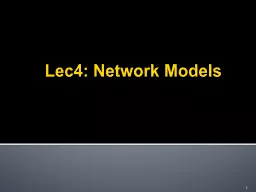

2 High Risk Medium Risk Low Risk Cost Low Medium High Used by Universities Companies amp organizations Military organizations Vulnerability to attacks High Medium Low Security Risk ID: 751439
Download Presentation The PPT/PDF document "Lec4: Network Models 1 Relationship Betw..." is the property of its rightful owner. Permission is granted to download and print the materials on this web site for personal, non-commercial use only, and to display it on your personal computer provided you do not modify the materials and that you retain all copyright notices contained in the materials. By downloading content from our website, you accept the terms of this agreement.
Slide1
Lec4: Network Models
1Slide2
Relationship Between Network Security & Cost
2
High
Risk
Medium RiskLow RiskCostLowMediumHighUsed byUniversitiesCompanies & organizationsMilitary organizationsVulnerability to attacksHighMediumLow
Security
Risk
CostSlide3
Graph that demonstrates the relationship between cost & security
3
Cost
Security
Risk
Low Security
Medium SecurityHigh SecuritySlide4
Architectural models for network management
Network management architecture consists of three sections:
Centralized:
Consists of a key management station.
Hierarchical :Consists of one main station at the center and various management stations distributed among the systems.Distributed: Consists of various stations for network management Distributed based on the geographic distance or function.4Slide5
Centralized Management Model
It is defined as a single network management system that runs network management applications and all the information are stored in a single centralized database.
Examples:
Open view (hp)
net view (IBM)Sepctrum5NM
Network Resource
Network Management system
NMSlide6
Advantages of the Centralized Management Model
Facilitates decision making.
Only single place is determined for network management.
Easy access to the centralized database.
Easy to expand and maintain the network.Highly secure.6Slide7
Disadvantages of the Centralized Management Model
In the case of failure in the network management, all the related network management systems will fail.
Overloading the network management system due to the large amount of the exchanged information.
7Slide8
Hierarchical model
Hierarchical
model is defined as a single network management system that manages various smaller network management systems that control network resources.
Examples:
Open view (hp)Cisco 8NM
NM
NMNetwork Resource
Network Management system
NMSlide9
B. Hierarchical Model (Cont.)
Advantages:
Distributing the load of the network.
Distributing the load of managing the network.
Bringing the network management systems closer to the managed network resourcesDisadvantages:High cost.Complicated and difficult in connection.9Slide10
Distributed Management Model
In this model network management systems are distributed on different indeterminate and in dependable places.
Examples:
CORBA(NCR)
DCOM(Microsoft) 10NMNM
NMNMNetwork Management system
NMSlide11
Distributed Management Model (Cont.)
Advantages:
Distributing the load on the entire network completely.
Easy to expand the network.
Reliable and consistent.Disadvantages:Very complicated.International standards are not yet defined. Low security.11Slide12
Network Management Model
12
Manager
Agent
MIBManaged Entity
Alerts
InstructionsManagement Stations
Resources
Management Information BaseSlide13
Network Management Model (Cont.)
Manager:
A program that receives alerts from agents and sends instructions to them.
Agents: A functional unit (Programs) located inside the managed devices (network resources) and provide management information to the devices and receives instructions to reconfigure the devices.13Slide14
Network Management Model (Cont.)
Managed Entity:
The network devices (resources) that is managed and controlled.
Management Information Base (MIB): A database of managed entities (resources) in the network and how they are accessed. Example:Remote Monitoring (Rmon) One of the most famous MIBs (management information bases) Used to monitor all the different components of LAN networks14